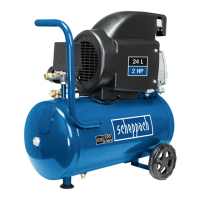www.scheppach.com
22
|
GB
• Do not process media such as white spirit, butyl al-
cohol and methylene chloride with the PVC pressure
hose. These media will destroy the pressure hose.
• The work area must be separated from the compres-
sor so that it cannot come into direct contact with the
working medium.
Operating pressure vessels
• You must keep your pressure vessel in good work-
ing order, operate the vessel correctly, monitor the
vessel, carry out necessary maintenance and re-
pair work immediately and meet the relevant safety
precautions.
• The supervisory authority may enforce essential
control measures in individual cases.
• A pressure vessel is not allowed to be used if it has
faults or deciencies that can endanger workers or
third parties.
• Check the pressure vessel for signs of rust and dam-
age each time before using. Do not use the com-
pressor with a damaged or rusty pressure vessel. If
you discover any damage, then please contact the
customer service workshop.
Do not lose these safety instructions.
6. Technical data
Mains connection 230 V~ 50 Hz
Motor rating max. 1500 W
Operating mode S1
Compressor speed 2850 min
-1
Pressure vessel capacity approx. 24 l
Operating pressure approx. 8 bar
Theoretical intake capacity approx. 220 l/min
Theoretical delivery rate approx. 110 l/min
Protection type IP20
Weight of the unit 21 kg
The noise emission values were measured in accord-
ance with EN ISO 3744.
Wear hearing protection.
The eects of noise can cause a loss of hearing.
• The compressor pump and lines can become very
hot during operation. Touching these parts will burn
you.
• The air which is sucked in by the compressor must
be kept free of impurities that could cause res or
explosions in the compressor pump.
• When releasing the hose coupling, hold the hose
coupling piece with your hand. This way, you can
protect yourself against injury from the rebounding
hose.
• Wear safety goggles and a respirator when working
with the compressed air pistol. Dusts are harmful
to health! Injuries can be easily caused by foreign
objects and blown away parts.
• Do not blow at people with the blow-out pistol and
do not clean clothes while being worn. Risk of injury!
Safety instructions when using spraying attach-
ments (e.g. paint sprayers)
• Keep the spray attachment away from the compres-
sor when lling so that no liquid comes into contact
with the compressor.
• Never spray in the direction of the compressor when
using the spraying attachments (e.g. paint sprayers).
Moisture can lead to electrical hazards!
• Do not process any paints or solvents with a ash
point below 55 °C. Risk of explosion!
• Do not heat up paints or solvents. Risk of explosion!
• If hazardous liquids are processed, wear protective
lter units (face guards). Also, adhere to the safety
information provided by the manufacturers of such
liquids.
• The details and designations of the Ordinance on
Hazardous Substances, which are displayed on the
outer packaging of the processed material, must be
observed. Additional protective measures are to be
undertaken if necessary, particularly the wearing of
suitable clothing and masks.
• Do not smoke during the spraying process and/or in
the work area. Risk of explosion! Paint vapours are
easily combustible.
• Never set up or operate the equipment in the vicinity
of a re place, open lights or sparking machines.
• Do not store or eat food and drink in the work area.
Paint vapours are harmful to your health.
• The work area must exceed 30 m³ and su cient
ventilation must be ensured during spraying and
drying.
• Do not spray against the wind. Always adhere to the
regulations of the local police authority when spray-
ing combustible or hazardous materials.

